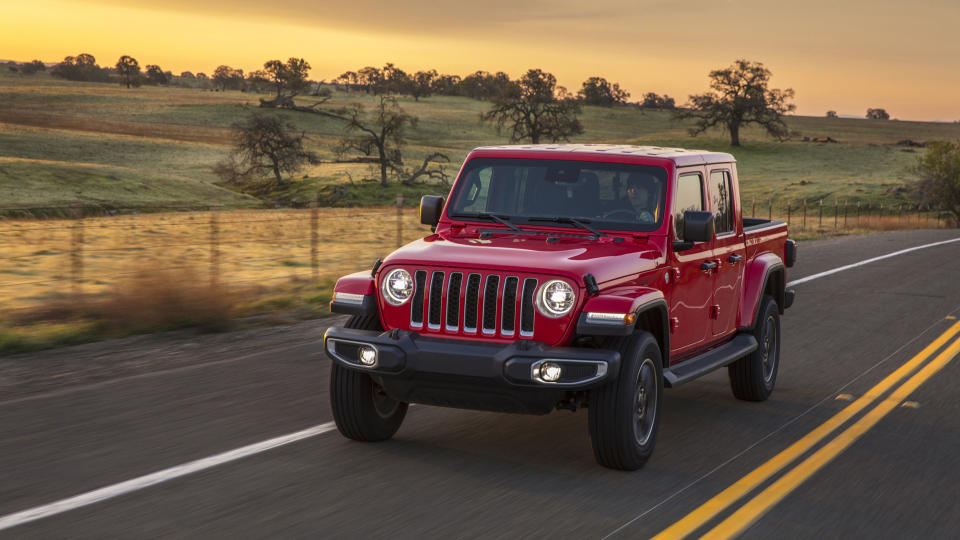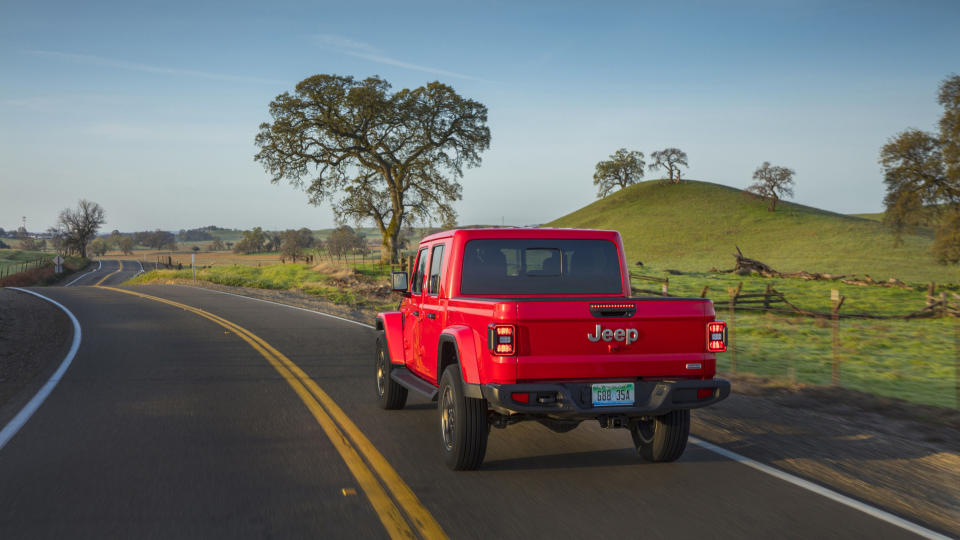2020 Jeep Gladiator Review and Buying Guide | Equal parts capability and character

In many ways, the 2020 Jeep Gladiator is the long-awaited and deeply desirable Wrangler pickup that Jeep fans and truck fans alike have been clamoring for. It has the iconic Wrangler look, the same interior, and fully removable roof panels and doors. And yep, the windshield even folds down, too. However, the Gladiator has a unique frame that's a whopping 31 inches longer than a Wrangler Unlimited, while the wheelbase is 19.4 inches longer. Basically, it's a whole different truck under all that Wranglerness, with an emphasis on "truck": It has the best towing capacity among midsize pickups and a 1,600-pound payload, along with a 5-foot bed. Oh, and how can we forget its off-roading potential?
So, whether you're looking for that long-sought Wrangler with a pickup bed, or just a capable and unique midsize truck, the 2020 Gladiator should definitely deliver.
What's new for 2020?
The Gladiator is an all-new model.
What's the Gladiator's interior and in-car technology like?
The Gladiator shares much of its interior with the Wrangler, which is a very good (and cool) thing. You get the same characterful and, in upper trims, colorful design constructed of materials that should seem almost shockingly opulent for hardcore Wrangler faithful. Jeep's serviceable 5-inch touchscreen is standard, but you can upgrade to either a 7- or 8.4-inch unit that improve functionality considerably (in part since they include Apple CarPlay and Android Auto). The fact that you sit rather close to the dash in the Gladiator means those big screens seem even bigger.
Like the Wrangler, the Gladiator is offered with either multi-panel soft- or hardtop roof designs. The soft top in particular is notable for allowing you to remove its rear panel while leaving the roof panel in place. This allows for free-flowing air without the sunburn. And, if free-flowing air is really your thing, the doors are removable and the windshield can be lowered after the removal of a few bolts.
The bed is only available in a 5-foot length and includes tie-down points and a power outlet.
How big is Gladiator?
The Gladiator is considerably longer than the Wrangler, but let's stick to comparisons with other midsize trucks. As it's only available with what effectively is a crew cab and short bed design, every Gladiator has the same length of 218 inches. That's 8 inches longer than the Ford Ranger, but about 7 inches shorter than the long-bed versions of the Chevy Colorado and Toyota Tacoma. It's a bit narrower than those as well. Basically, the Gladiator is in the heart of the midsize pickup segment.
The interior is a different story, where there's ample space for four adults to sit comfortably. At 38.3 inches, there are a couple more inches of rear-seat legroom in the Gladiator than in any of its competitors. We had no trouble putting one 6-footer in the rear seat behind another similarly tall person in a comfortable driving position. Front and rear headroom are also class-leading.
What's the Gladiator's performance and fuel economy?
Like the Wrangler, the 2020 Jeep Gladiator comes standard with FCA's 3.6-liter V6 that produces 285 horsepower and 260 pound-feet of torque. A six-speed manual is standard, and an eight-speed automatic optional. EPA-estimated fuel economy is 17 mpg city, 22 mpg highway and 19 mpg combined with the automatic, and 16/23/19 with the manual. That's 3 mpg worse than the turbocharged Ford Ranger.
Unlike the Wrangler, however, the Gladiator does not offer Jeep's own turbocharged engine option. A 3.0-liter diesel V6 has been promised by Jeep, but hasn't yet shown up in dealerships.
How much can Gladiator tow and haul?
The Gladiator's maximum 1,600-pound payload and 7,650-pound tow rating are achieved with the base (and lightest) Sport trim level, while the Rubicon maxes out at 7,000 pounds. By way of comparison, a four-door Toyota Tacoma TRD Pro can tow as much as 6,800 pounds, the Colorado 7,000, and the Ranger 7,500.
We towed a 5,500-pound Airstream trailer for several miles using a Gladiator Sport equipped with an automatic transmission and all the requisite towing gear, including a Mopar-branded trailer brake controller. Buyers who plan on regularly hauling anything that heavy will likely want to opt for a fullsize pickup, but we can confirm that the Gladiator will handle the load just as well as any of its midsize competitors. The engine feels a little stressed as it pushes the Gladiator and trailer up to highway speed, but its transmission holds gears well with no intervention from the driver, and appropriately adapts to uphill and downhill grades.
Its payload capacity of between 1,105 and 1,600 pounds is similarly in the ballpark for the segment, though it should be noted that only the Ranger (1,860 pounds) outdoes its max payload.


What's Gladiator like to drive?
The Gladiator drives a lot like the Wrangler Unlimited. No surprise there. The ride is a bit less busy due to the truck's much longer wheelbase and additional weight, and it would likely further improve with some weight in the bed. Base Sport models get 17-inch wheels shod in 245/75 tires, and so equipped, the Gladiator's power steering feels very light and overboosted, requiring a lot of small corrections to keep the truck pointed straight ahead at highway speeds. In Rubicon trim, the Gladiator gets 33-inch all-terrain tires with soft sidewalls, with blockier mud-terrain tires optional. It sounds strange, but those heavier tires dampen some of the lightness from the steering, and that offers a driving experience that we prefer over the base model. Jeep representatives told us that a large percentage of Sport buyers will accessorize their Gladiators with new wheels and tires directly after taking delivery, so tuning the steering for off-road-spec tires makes sense.
In regular driving on surface streets and highways, the Gladiator's V6 engine feels sufficient. There isn't a whole lot of joy in the art of shifting the Gladiator's manual gearbox, but somehow a clutch pedal in a Wrangler-based vehicle just feels right. In reality, though, nearly everyone is going to opt for the eight-speed automatic. It's a good transmission that doesn't unnecessarily hunt for gears and mostly disappears into the background, pairing well with the V6.

 Yahoo Autos
Yahoo Autos 




